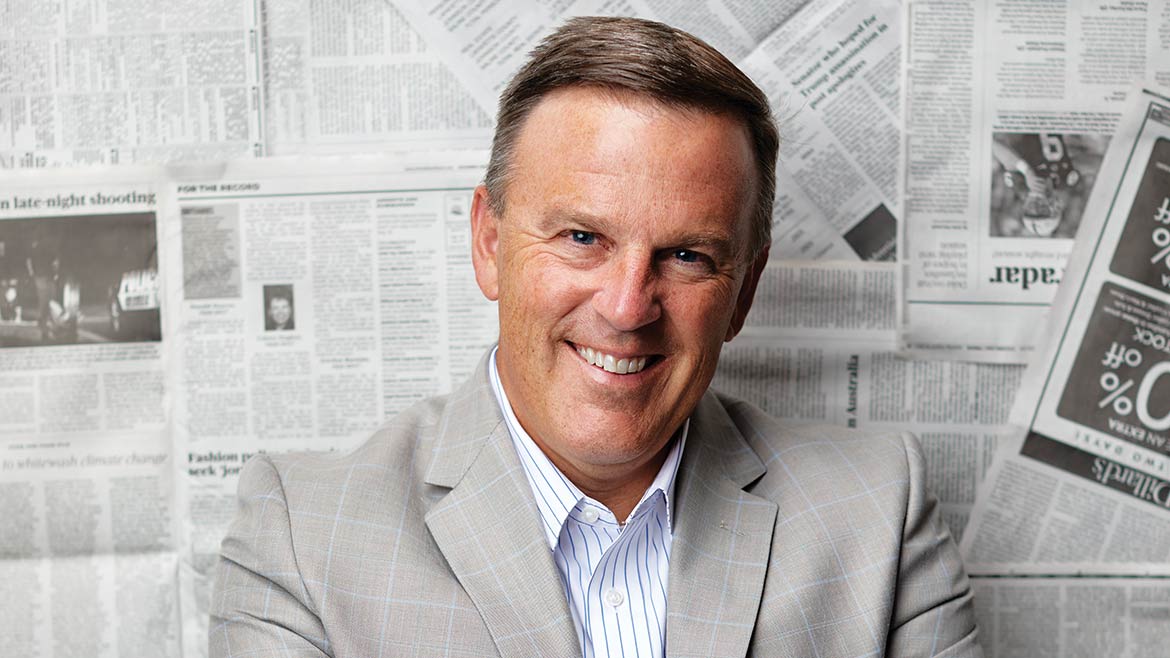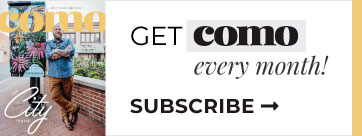The Second Act: Former Journalists Find Life Beyond the News Cycle
- photos by Keith Borgmeyer

Veteran newsman Scott Charton rues the dwindling number of locally- and family-owned community media outlets — those like the radio station that took a chance on him when he was an eager, enthusiastic barely-16-year-old and got his media career started.
There’s an uncanny similarity in our stories. I was barely 16 when Norman Gallagher hired me in November 1979 to write school news for The Belle Banner, my hometown newspaper. He paid me $25 a week and gave me my own office. My head swelled too large to notice that the paltry sum foreshadowed things to come —my chosen career consistently paid far less than most professions.
Charton’s sorrow over the far fewer opportunities for young people to connect with their local newspaper and radio stations is understandable. My worry is that fewer of the corporate types now gobbling up newspapers can recognize the heady aroma of printer’s ink and newsprint.
My family lived in an apartment right next to The Belle Banner. I learned that every Wednesday morning, the clank-clunk-whir coming from the Banner was the press spitting out the next edition of the paper. The day a pressman led me into the press room and showed me the guts of the building changed my life forever. Some moments in life have a distinctly deep, sacred connection to our souls. For me, that was one of those moments.
Meet three individuals who are thriving and utilizing the skills they picked up as journalists, even though they’ve moved on to other opportunities.

John Fougere
________________________________________________
Education
Springfield College, bachelor’s degree in English and history; MU School of Journalism, master’s degree in broadcast journalism.
Position
Vice president of communications, William Woods University
Journalism background
Television and radio for eight years in Columbia; Peoria, Illinois; and Medford, Oregon
________________________________________________
Leaving the East Coast with his father’s blessing, John Fougere expected to be in Columbia only however long it took to earn a broadcasting degree from the Missouri School of Journalism.
“My dad said, ‘What a great place. You should go out there and spend a couple years before you move back,’” Fougere recalls, smiling broadly.
That was 1989, but it’s been more than a couple years.
“Life has a way of intervening,” he says. Life intervened with a stint as a television sports anchor and reporter, and then with an unexpected career in public policy and communications at the highest levels of state government and higher education in Missouri.
Fougere got “bit by the broadcast bug” while writing for the Springfield (Massachusetts) College campus newspaper, and his career trajectory pointed that direction. He worked in Oregon and Illinois before landing a four-year stint as a sports anchor at ABC 17 in Columbia, but the somewhat low-paying and itinerant nature of sports broadcasting didn’t meld all that well with a new plan to be a husband and father.
“I was going to have to move around the country,” to move up in broadcast, Fougere notes. He and his wife, Sarah, who operates a catering business here, welcomed their first son in 1997. “I just wasn’t willing to move around the country like that.”
Fougere had an interest in public policy and government — his pre-broadcasting plan back in Massachusetts was to be a high school history teacher and coach — so when he was introduced to then-Governor Mel Carnahan’s spokesman, Chris Sifford, he seized the opportunity. That meeting led to a call to serve as the public information officer for the Missouri Department of Corrections, a job Fougere held for eight years.
The hours and the salary were “more stable,” but it was a stark transition.
“It was akin to learning how to swim by somebody throwing you in the deep end and saying, ‘Swim,’” Fougere says. There was “constant media attention” for prison escapes, parolees committing felonies, and executions.
“You really, really quickly learn how to handle crisis media,” he says. “But I wouldn’t trade anything for those eight years.”
The next job came from Attorney General Jay Nixon, who’d seen Fougere handle communications about missing (and potentially escaped) prisoners who were eventually found inside the old state penitentiary. Nixon offered him the job of press secretary.
It was a potentially risky career move for Fougere — it was clear that Nixon would run for governor in three years. But three years later, when Nixon was elected to the first of two terms as governor, Fougere was appointed as communications director for the Missouri Department of Economic Development. He remembers Nixon telling him: “John, here’s the deal. The economy’s not going well right now. And if you don’t do your job well and I don’t do my job well, we’re both going to be looking for work in four years.”
In 2013, Fougere left state government for higher education to become director of communications for the UM System. The post put him in a challenging position in 2015, when the MU campus was thrust into the spotlight of national media by racial strife and protests.
As the MU campus tried to find its footing, enrollment declined drastically. In June, some 400 UM System positions were eliminated, including Fougere’s.
“It was challenging. It was really painful to see it go through that process,” he says. “Hopefully the university will bounce back. I love Mizzou. I will always love Mizzou.”
Barely two months after the layoff, Fougere was tapped by William Woods University President Jahnae Barnett to become the vice president of communications for the private liberal arts college in Fulton. Under Barnett’s leadership, which began in 1990, William Woods has transformed from a campus of 700 students to more than 2,000.
“You can’t say that about a lot of small colleges,” Fougere says. “They’ve been able to really flourish in what is a very difficult market.”
Fougere joked that journalists once said he was “going over to the dark side” when he took a job in public relations, but he’s adamant about staying grounded in integrity.
“I always thought it was extremely important, when you’re a spokesman for an organization, that you absolutely believe in the vision and mission of the organization,” he says. “I’ve been lucky to have that situation throughout my career.”
Each career stop has meant mastering sundry subject matter. Journalists are primed to be in those types of positions.
“If you were a general assignment reporter, you have to master a lot of subject matter. You have to know a little bit about everything,” Fougere says. “If you can do that, you’ll be in demand.”

Madison Loethen
Education
Bachelor’s degree from Lindenwood University with double majors in broadcast journalism and public relations.
Position
Multimedia marketing specialist, Boone Hospital Center
Journalism background
ABC 17 reporter, Newsy anchor and producer
Interests
Her self-titled lifestyle blog and YouTube channel:
madisonloethen.com & youtube.com/madisonloethen
The next chapter in Madison Loethen’s journey from journalist to multimedia specialist, blogger and vlogger, viral video star, and focus of one episode of HGTV’s “House Hunters” (which will air this fall) will be challenging to write. Matching the storybook events that have already unfolded for the 26-year-old is a tall order.
Loethen grew up in St. Louis, went to Lindenwood College, and came to Columbia to be a reporter and producer at ABC 17. After a year at KMIZ and a year as an editor at Newsy, the multimedia news startup, Loethen had seen seasoned reporters produce and write compelling stories, but she also saw the long, odd hours and the constant challenge that tugged reporters into a news-gathering mindset — even after that day’s news-gathering was over.
“I wasn’t sure I wanted a lifetime of that,” Loethen says. “I wanted a work–life balance.”
Loethen now uses her skills as a multimedia marketing specialist at Boone Hospital Center, where she produces videos and stories about patients and hospital staff overcoming long odds, making new achievements in health and medicine, or demonstrating excellence.
“I love telling patient stories,” she says. “They are treated by some wonderful people here.”
Loethen still sees herself as a journalist, in many ways. “I still use a lot of the same skills,” but instead of giving news, “I’m promoting a company that I believe in.” It’s advice she offers to other former journalists, perhaps displaced by corporate downsizing or looking for a better work–life balance.
When she left the news field, Loethen applied for jobs in health care in part because she was a health reporter and producer and also because her family has a history of heart disease. If she wasn’t working for Boone, Loethen says she’d probably be connected with another nonprofit health care organization.
But her professional communications career is only part of the story. Her side career started with the engagement ring that led to a viral video featured on “Good Morning America”; Loethen parlayed that exposure into a lifestyle blog and YouTube channel with thousands of followers.
And what about that video? As part of a national campaign, Helzberg Diamonds gave Kyle Loethen a chance to get Madison’s engagement ring at no charge — on the condition that he propose in the next 48 hours. Kyle agreed, and the company filmed the next two days for a short documentary that ended with the proposal, Madison’s tearful, smiling “yes,” and Madison asking, “How did you do all this?” (“It’s a long story,” Kyle responded.)
Kyle is also no stranger to the camera — he’s a model and actor with a number of St. Louis and Kansas City area television commercials to his credit. The couple will appear on “House Hunters” later this fall. The HGTV show takes viewers behind the scenes as participants check out three homes to decide which one to buy and move into.
By the time the episode airs, Loethen will already be a veteran of television and, with her lifestyle passion project, of cyberspace. On her blog, she offers home-spun but classy observations about fashion, beauty, cooking and meal-planning (gluten-free), wedding tips, and more.
Her creative energy seems boundless and comes from multiple sources: “Making people smile, sharing a healthy recipe, creating content that’s positive,” she says. Providing fresh and consistent blog material once or twice a week is helping her earn some side money through sponsorships.
“It’s kind of exciting to see that take off this year. If it could be more in the future, that would be awesome,” Loethen says, adding that she’s not yearning to leave Boone Hospital yet — she loves being part of the marketing and health team.
Her blogging gig and her marketing role at the hospital help Loethen stay on top of current technology trends, popular topics, and effective ways of reaching a target audience. It seems like a good recipe to follow.
“I think you just never know what the future holds,” she says. “You kind of have to roll with the punches.”

Scott Charton
________________________________________________
Education
Hendrix College, University of Central Arkansas, and University of Arkansas-Little Rock, majoring in political science and history.
Position
Self-employed, Charton Communications and Consulting, since spring 2008; director of communications for the UM System
Journalism background
Radio, television, and newspaper; longest chapter was nearly 25 years with the Associated Press
________________________________________________
Scott Charton’s Facebook page is a steady stream of national events, presidential politics, local happenings — that recent fire at Broil, for instance — and a bevy of pet photos. It’s not unlike the Associated Press news ticker that once click-clacked non-stop news from near and far. Except for the pet photos.
His online life certainly features a colorful assortment of his fellow former reporters and broadcasters. But when it comes to dispensing wisdom about life after journalism (he prefers to call it a “second act”), Charton channels Mr. Rogers. The children’s TV star used to tell troubled children to “find the helpers.”
There’s abundant confusion among the public about the nature of news: what’s reliable, what’s “fake,” what’s going on. “I would say to confused adults, ‘Find the explainers,’” Charton says. “Journalists who have had long careers, especially specializing in certain beats, are well-situated to be explainers.”
Natural curiosity led Charton to a career as an explainer, a storyteller, and a reporter. He was intrigued by Ted Knight’s self-aggrandizing Ted Baxter character on the “Mary Tyler Moore Show,” mesmerized by watching the Watergate hearings, and later fascinated by the Associated Press, the organization that Charton eventually poured himself into for years.
Charton was 15 when he asked for a job at his hometown’s 200-watt radio station. He was told to check back after he had a driver’s license. In September 1977, three months after turning 16 and despite a soon-to-be-vanquished fear of public speaking, Charton landed that radio job.
His first interview of a public official? That was soon-to-be Arkansas Governor Bill Clinton.
Between the first radio gig, dropping out of college, covering the Louisiana State Capitol, re-enrolling in college, and then directing a weekly public affairs television show at the age of 21, he became a broadcast editor for the AP. Six years later, Charton was invited to be the AP correspondent in Jefferson City, a job he held from 1989 to 2001.
Charton reported on and rubbed shoulders with elected officials and fellow reporters, building a rich database of relationships and memories. But he was taking a break from the daily grind on an AP-approved sabbatical when the Second Act unfolded.
“The allure of getting called out to cover a tornado halfway across the state dimmed in my 40s,” Charton says in his typical, affable fashion.
Then-UM System President Elston Floyd contacted Charton for a stint as a “listener” on a statewide tour to get feedback about the system and higher education. The gig with Floyd blossomed into something much more, and Charton was offered a full-time post to reorganize and subsequently lead the UM System’s communications department.
“It was an amazing experience working for Elston Floyd,” Charton says. “He knew what needed to be done and had the courage to do it.”
Three years to the day after teaming up with the UM System and serving as the chief spokesman, Charton left the job and created Charton Communications and Consultants. In addition to “finding facts, researching, and writing” – basically a journalist who was advocating and not just telling stories – Charton’s self-employment also includes writing speeches and helping produce a pair of Emmy-award winning documentaries for the Missouri Press Association. One of the documentaries chronicled the Joplin Globe staff’s response to and coverage of that city’s devastating tornado in May 2011.
Charton is selective when it comes to issues and clients. “I won’t lie for a client, but I will help them put their best message forward.” He also manages an occasional state or local ballot issue campaign, a role that has produced all winners. No political candidates, though. “A ballot issue can’t get arrested or get into an embarrassing position that will end up on Page A1 that someone’s mother or grandmother will see,” Charton says.
His most recent success: Boone County’s Proposition 1, which extended the road and bridge sales tax. Charton helped stage more than 30 public presentations in five weeks about the tax. The proposition received 86 percent approval.
“On a tax issue,” Charton says. “That was a tremendous source of satisfaction.”
Though he’s no longer in the business of journalism, there’s still ample need for the same skills. “You still need credible content and smart communicators,” he says. “You need to say it plainly and help people understand it. And that is my whole practice — and I do it while employing the techniques of a reporter. I’m still getting to do the things I’ve always loved and getting new ways to do it.”


